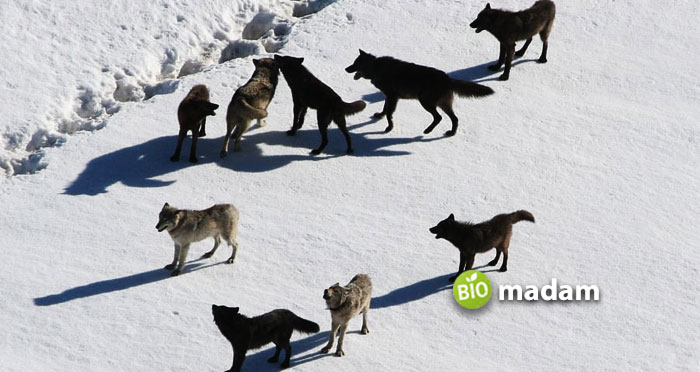All organisms around us are categorized into different groups called kingdoms, further divided into phyla according to their similarities and differences. This classification method is the taxonomic classification system and comprises a complex system of categorizing organisms into various groups. Species are the lowest level of classification in the taxonomic organization. However, sometimes, biologists categorize them further to study the unique characteristics of groups within the species. These groups are known as subspecies.
This article will cover all the aspects and characteristics that differentiate species from subspecies.
Comparison Table
| Characteristics | Species | Subspecies |
| Definition | The lowest level in taxonomic classification | Groups within species |
| Visible Differences | Physical characteristics, genetic similarities, and ecological factors | Habitat and diet |
| Naming Criteria | Two parts | Three parts |
| Scientific Name E.g. | Canis lupus | Canis lupus occidentalis |
What are Species?
A species is defined as groups of organisms or populations that can potentially interbreed freely and are reproductively distinct from other such groups of populations.

Species comprise groups of populations from common ancestors with similar appearance and characteristics. However, they are distinct from other organisms and microorganisms with a morphological gap. Species is the most objective part of the taxonomic hierarchy. While two different species might not interbreed, there is a high chance that they might have a reproductive status between them. Higher taxonomic ranks like genus and species are categorized based on anatomical differences. They belong to different lines of evolution; many of their members have adapted to the same environments and niches.
Species are essential in biology because they allow us to study the relationships between different organisms and the mechanisms of speciation, evolution, and natural selection.
What are Subspecies?
A subspecies is a taxonomic rank below that of a species. It describes a population of organisms within a species with some distinguishing features, such as physical or genetic differences. However, they can still interbreed and produce viable offspring from other populations within the same species.
Subspecies are often defined based on geographical or ecological factors, such as differences in habitat or diet. It is possible to distinguish them based on morphological, physiological, or genetic characteristics, such as differences in coloration, size, or genetic markers. Subspecies are significant in studying biodiversity, as they help to classify further and understand the variation within a species. Also, they are used in conservation efforts to identify and protect distinct populations at risk of extinction.
The scientific name of a subspecies follows the same format as a species, with the genus name followed by the specific epithet and then the subspecific epithet. An example of a gray wolf subspecies found in North America is Canis lupus occidentalis.

Differences between Species and Subspecies
Definition
Species
Species are defined as the most fundamental classification level according to the taxonomic classification.
Subspecies
Subspecies are groups of organisms within the species, categorized to better study the traits of organisms.
Taxonomic Classification
Specie
A “species” is a fundamental unit of biological classification that refers to organisms that can interbreed and produce fertile offspring.
Subspecies
A subspecies is a taxonomic rank below the species, used to describe a population of organisms within a species with some distinguishing features.
Characteristics Difference
Species
Species are typically based on shared physical characteristics, genetic similarities, and ecological factors. They represent a distinct evolutionary lineage, and their members are often adapted to similar environmental conditions and niches.
Subspecies
At the same time, subspecies are often defined depending on geographical or ecological factors, such as differences in habitat or diet. They can also be determined based on morphological, physiological, or genetic characteristics, such as differences in coloration, size, or biological markers.
Scientific Naming Criteria
Species
The scientific name of a species consists of two parts: the genus name and the specific epithet.
Subspecies
In contrast, the scientific name of a subspecies includes an additional third part, the subspecies handle.
Naming Example
Species
The scientific name of the gray wolf species is Canis lupus.
Subspecies
However, the scientific name of the subspecies of gray wolf found in North America is Canis lupus occidentalis.
The Bottom Line
Species and subspecies are classifications of organisms based on similarities and differences to study their characteristics better. Species are the lowest level of organization according to the taxonomic classification system proposed by Carl Linnaeus. Scientists and researchers have further proposed subgroups in species, known as subspecies. They have similar ecological and evolutionary characteristics with similar ancestors but may have varying habitats. The species name comprises two parts, while the subspecies name also contains an additional part distinguishing it from the species name.
FAQs
What is the difference between genus and subspecies?
The genus is the level of taxonomic classification or taxonomy between Family and Species. On the other hand, sub-species are similar, distinct groups within a species. The genus-subspecies relationship is critical to naming organisms in subspecies.
What species have subspecies?
Many species have been categorized into subspecies, including gray wolves and tigers. The subspecies of tigers include Panthera tigris tigris, Panthera tigris sumatrae, and Panthera tigris altaica.
Is a lion a subspecies?
Lions are also grouped into subspecies according to their habitats and niches. They are categorized into the Asian lion Panthera leo persica and the African subspecies Panthera leo.
What are the 2 subspecies of humans?
While the more common subspecies of humans or Homo sapiens species are the modern Homo sapiens, another subspecies classification is the archaic Homo erectus.
What is the 75% rule for subspecies?
The 75% rule is the standard rule for defining subspecies. It states that 75% of the population must lie outside the 99% of the other population’s range for a particular characteristic or set of characteristics.

Hello, I would like to introduce myself to you! I am Chelsea Rogers, an experienced blog writer for science articles, holding an MPhil degree. My enthusiasm to grab the best knowledge, let it relate to botany, zoology, or any other science branch. Read my articles & let me wait for your words s in the comment section.

